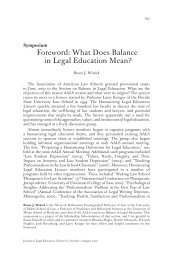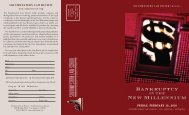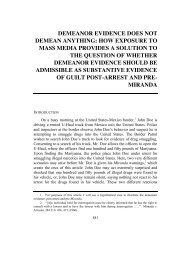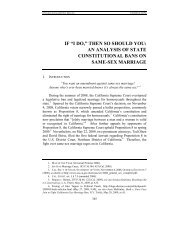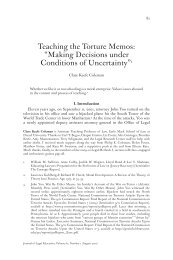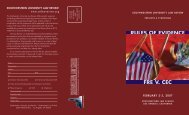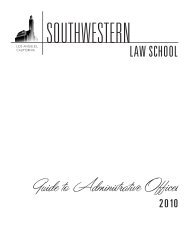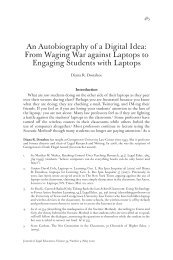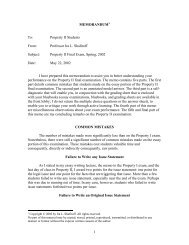What is Art? - Southwestern Law School
What is Art? - Southwestern Law School
What is Art? - Southwestern Law School
- No tags were found...
You also want an ePaper? Increase the reach of your titles
YUMPU automatically turns print PDFs into web optimized ePapers that Google loves.
WHAT IS ART? 127calling expert witnesses to convey one key message for the jury: forgoodness’ sake, th<strong>is</strong> <strong>is</strong> art on trial, not mass murder. 71 An array of eminentart experts gave evidence for the defence. They offered the juryearnest, erudite, entertaining, and illuminating d<strong>is</strong>courses about theh<strong>is</strong>torical lineage of art as currency, bartering traditions, the economicvalue of art, the art marketplace, Dada, 72 appropriation of found objectsby art<strong>is</strong>ts, 73 Conceptual<strong>is</strong>m, 74 Performance <strong>Art</strong>, 75 Trompe-l’oeil, 76and Pop <strong>Art</strong>. 7771. The nature and flavour of the defence’s appeal to the jury are captured in thefollowing extracts from defence counsel’s opening address: “The Mona L<strong>is</strong>a <strong>is</strong> not a reproductionofanItalianwoman,andVanGoghdidnotreproducesunflowers...Boggs<strong>is</strong> not an art<strong>is</strong>t of that calibre—and being an art<strong>is</strong>t would in any case be no defencein itself—but if you just look at h<strong>is</strong> drawings you will see that they are not reproductions. . . but an art<strong>is</strong>t’s impression, objects of contemplation . . . they had never beenpassed off as real currency . . . and not even a moron in a hurry would m<strong>is</strong>take thesedrawings for the real thing, they are obviously drawings . . . Boggs <strong>is</strong> no mere reproducer,he’s an art<strong>is</strong>t. You may or may not like what he does. You may find what hedoes of value. You may feel that a Boggs <strong>is</strong>n’t worth the paper it’s drawn on . . . butthat’s not the point. The point <strong>is</strong> that these are original works of art and not reproductionsat all.”72. “Dada <strong>is</strong> the groundwork to abstract art and sound poetry, a starting point forperformance art, a prelude to postmodern<strong>is</strong>m, an influence on pop art, a celebration ofanti-art to be later embraced for anarcho-political uses in the 1960s and the movementthat lay the foundation for Surreal<strong>is</strong>m.” See FRANCIS PICABIA (TRANS. MARC LOW-ENTHAL), I AM ABEAUTIFUL MONSTER: POETRY, PROSE, AND PROVOCATION (2007).73. Marcel Duchamp (1887–1968) used found objects and exhibited them as h<strong>is</strong>own artworks from around 1915. He called them Readymades. He challenged traditionalnotions of what art could be, and especially the idea of art being of aestheticor ‘retinal’ value: “My idea was to choose an object that wouldn’t attract me, eitherby its beauty or by its ugliness. To find a point of indifference in my looking at it,you see.” (Interview, BBC TV, 1966.) Duchamp <strong>is</strong> widely accepted as the most influentialart<strong>is</strong>t of the 20th Century, being the progenitor of Conceptual <strong>Art</strong>. See http://www.metmuseum.org/toah/hd/duch/hd_duch.htm.74. Sol LeWitt (1928–2007) was a progenitor of Conceptual <strong>Art</strong> in the UnitedStates in the 1960s: “In conceptual art the idea or concept <strong>is</strong> the most important aspectof the work. When an art<strong>is</strong>t uses a conceptual form of art, it means that all of the planningand dec<strong>is</strong>ions are made beforehand and the execution <strong>is</strong> a perfunctory affair. Theidea becomes a machine that makes the art.” Quoted from LeWitt’s article Paragraphson Conceptual <strong>Art</strong>, ARTFORUM, June 1967.75. Performance <strong>Art</strong> emerged in the 1950s, and especially the 1960s and 1970s, vianotable v<strong>is</strong>ual art<strong>is</strong>ts such as Joseph Beuys, Vito Acconci, Yves Klein, Yoko Ono,Barbara T Smith, and Carolee Schneemann. Sometimes called “live art”, it eludes prec<strong>is</strong>edefinition, embracing unscripted or unchoreographed events presented with orwithout audience involvement, not necessarily in an art gallery, lasting for any lengthof time. Marina Abramović (1946–) <strong>is</strong> the most widely known performance art<strong>is</strong>t currentlyperforming around the world.76. The ancient technique of “perspectival illusion<strong>is</strong>m” (optical illusion) has beenemployed by art<strong>is</strong>ts since time immemorial.77. Pop <strong>Art</strong> developed in the UK and the U.S. in the 1950s, challenging conventionby appropriating mass-produced v<strong>is</strong>ual images and icons of popular culture from advert<strong>is</strong>ements,comic books, product and packaging designs, telev<strong>is</strong>ion, and film; oftenusing industrial processes to make “multiple originals” such as photo-silkscreenprinting.




